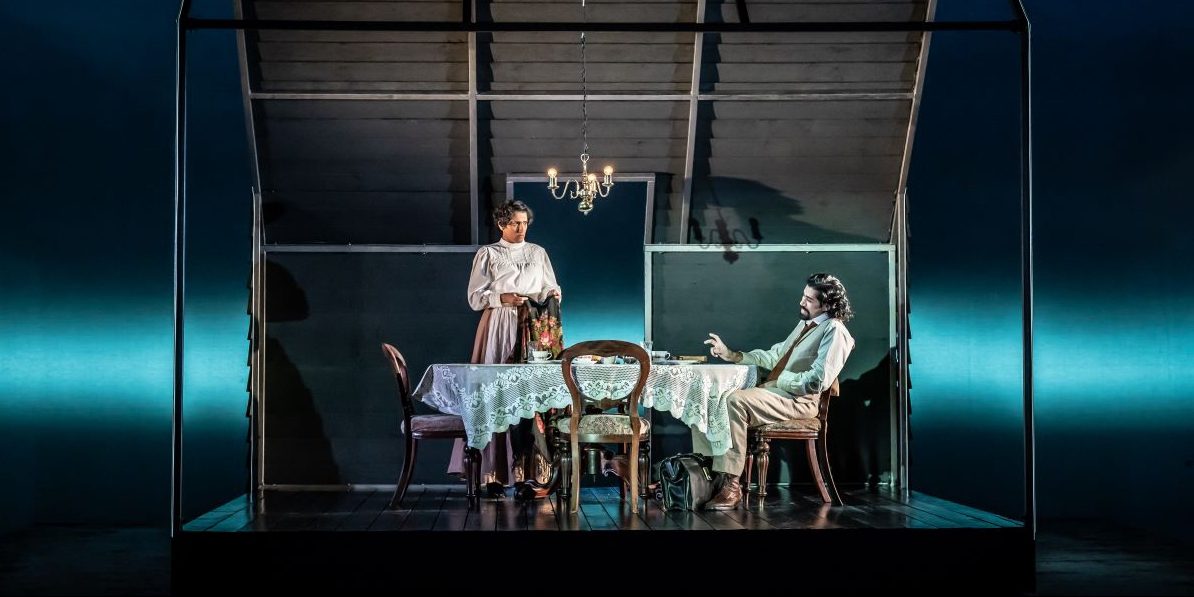This year’s choice for the Guildhall School’s main winter drama is a classic twentieth-century American drama, Thornton Wilder’s epic portrait of local life, love and loss: ‘Our Town’, dating from 1938. The three acts dive into the life of the small New Hampshire community of Grover’s Corners at three points between 1901 and 1913. Rather like our own ‘Under Milk Wood’ it covers all the great themes of life but filtered through a host of characters interacting with one another in the mundane rituals of daily life. But the intervention of a stage manager (a role split up several ways in this production) enables a more metaphysical perspective to emerge, especially in the much darker final scenes set in the town cemetery. The emphasis comes to rest on the sheer transience of life and how we don’t appreciate the key moments of joy and fulfilment until they are long gone and merely the province of wistful memory.
In some ways this is an ideal play for a student production led by a professional creative team. There are many parts of different sizes, so a whole year of students can be accommodated, and the many moods and different dynamics of the play provide excellent training. But in other ways this is not a wholly successful choice. The first two acts have not aged well: the scenes are slow moving in exposition and quite saccharine in sentiment despite moments of humour. This is partly redeemed by the final act which still packs a real punch. Yet there are many flat patches that either could be cut to advantage or delivered with greater pace and flow. The fact that there are three stage managers in each act interrupting the action is very democratic but slows down the action and delivery substantially. Less reverence and more urgency would have served this production well.
The performance takes place in a reconfigured Silk Street Theatre, with the audience on three sides, framing an open gravel area punctuated by movable cubes and with a flexible house structure at the rear of the stage. Many of the roles are very well taken, but some of the cast would have benefited from more experience of projecting dialogue in these complex spaces. There were moments of inaudibility as a result alongside moments of rare intimacy and raw emotion.
One of the great strengths of any production at the Guildhall is in the successful blending of music into the action. There was some lovely, idiomatic singing from some of the principals and a fine choral mix for the scenes involving the local choir. This ensured that for weddings and funerals and other set piece ensembles the impact was impressive. Likewise, the movement was well-conceived so that it was plausible from all angles and even in the more intimate scenes there was always something visually intriguing taking place. I was particularly taken by the care with which the animated spirits of the dead found a restless stiffness that reflected their fretful lack of repose.
In the lead roles of George Gibbs and Emily Webb, Abdul Sessay and Miriam Petche successfully traverse a broad emotional spectrum from High School sweethearts through to married life and sudden death. They create a meaningful chemistry between them that is affecting, and they register their commitment to the values of community in a way commands respect – reminding you that Frank Capra’s ‘It’s A Wonderful Life’, another celebration of home with sombre edges, is of the same vintage.
There is no room here to elaborate on all the many characterful portrayals, but for me the two matriarchs, Mrs Gibbs and Mrs Webb stood out. Arinder Sadhra and Lola Shalam demonstrated that the burden of work and decision-making in towns of this type and time essentially rested with the women. They showed toughness and tenderness as needed. As Dr Gibbs, Sachin Krishan Sharma found a world-weary charm that evoked Chekhov’s Dr Astrov, and Joseph Clark revealed plenty of uncomfortable layers in the unhappy drunken choirmaster, Simon Stimson. Curt Ray delivered two well contrasted cameos as a finicky professor and an empathetic funeral director.
At the end of a long evening this play was greeted with great enthusiasm by the audience, but I was left thinking that this classic text needs more interventionist direction and some abbreviation if it is to succeed across all three acts as a unified and convincing whole.

